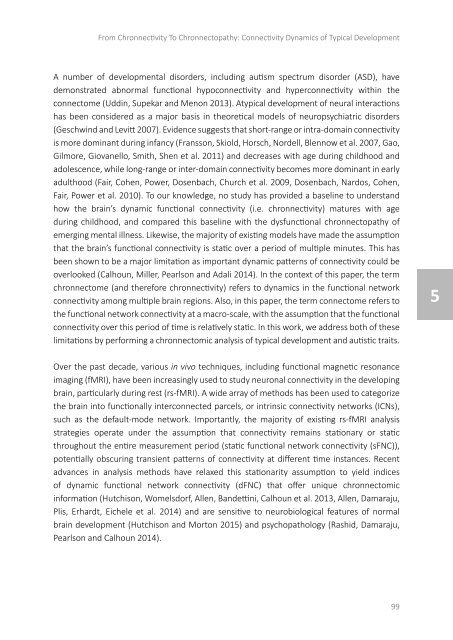On the Spectrum
2lm5UyR
2lm5UyR
You also want an ePaper? Increase the reach of your titles
YUMPU automatically turns print PDFs into web optimized ePapers that Google loves.
From Chronnectivity To Chronnectopathy: Connectivity Dynamics of Typical Development<br />
A number of developmental disorders, including autism spectrum disorder (ASD), have<br />
demonstrated abnormal functional hypoconnectivity and hyperconnectivity within <strong>the</strong><br />
connectome (Uddin, Supekar and Menon 2013). Atypical development of neural interactions<br />
has been considered as a major basis in <strong>the</strong>oretical models of neuropsychiatric disorders<br />
(Geschwind and Levitt 2007). Evidence suggests that short-range or intra-domain connectivity<br />
is more dominant during infancy (Fransson, Skiold, Horsch, Nordell, Blennow et al. 2007, Gao,<br />
Gilmore, Giovanello, Smith, Shen et al. 2011) and decreases with age during childhood and<br />
adolescence, while long-range or inter-domain connectivity becomes more dominant in early<br />
adulthood (Fair, Cohen, Power, Dosenbach, Church et al. 2009, Dosenbach, Nardos, Cohen,<br />
Fair, Power et al. 2010). To our knowledge, no study has provided a baseline to understand<br />
how <strong>the</strong> brain’s dynamic functional connectivity (i.e. chronnectivity) matures with age<br />
during childhood, and compared this baseline with <strong>the</strong> dysfunctional chronnectopathy of<br />
emerging mental illness. Likewise, <strong>the</strong> majority of existing models have made <strong>the</strong> assumption<br />
that <strong>the</strong> brain’s functional connectivity is static over a period of multiple minutes. This has<br />
been shown to be a major limitation as important dynamic patterns of connectivity could be<br />
overlooked (Calhoun, Miller, Pearlson and Adali 2014). In <strong>the</strong> context of this paper, <strong>the</strong> term<br />
chronnectome (and <strong>the</strong>refore chronnectivity) refers to dynamics in <strong>the</strong> functional network<br />
connectivity among multiple brain regions. Also, in this paper, <strong>the</strong> term connectome refers to<br />
<strong>the</strong> functional network connectivity at a macro-scale, with <strong>the</strong> assumption that <strong>the</strong> functional<br />
connectivity over this period of time is relatively static. In this work, we address both of <strong>the</strong>se<br />
limitations by performing a chronnectomic analysis of typical development and autistic traits.<br />
5<br />
Over <strong>the</strong> past decade, various in vivo techniques, including functional magnetic resonance<br />
imaging (fMRI), have been increasingly used to study neuronal connectivity in <strong>the</strong> developing<br />
brain, particularly during rest (rs-fMRI). A wide array of methods has been used to categorize<br />
<strong>the</strong> brain into functionally interconnected parcels, or intrinsic connectivity networks (ICNs),<br />
such as <strong>the</strong> default-mode network. Importantly, <strong>the</strong> majority of existing rs-fMRI analysis<br />
strategies operate under <strong>the</strong> assumption that connectivity remains stationary or static<br />
throughout <strong>the</strong> entire measurement period (static functional network connectivity (sFNC)),<br />
potentially obscuring transient patterns of connectivity at different time instances. Recent<br />
advances in analysis methods have relaxed this stationarity assumption to yield indices<br />
of dynamic functional network connectivity (dFNC) that offer unique chronnectomic<br />
information (Hutchison, Womelsdorf, Allen, Bandettini, Calhoun et al. 2013, Allen, Damaraju,<br />
Plis, Erhardt, Eichele et al. 2014) and are sensitive to neurobiological features of normal<br />
brain development (Hutchison and Morton 2015) and psychopathology (Rashid, Damaraju,<br />
Pearlson and Calhoun 2014).<br />
99


